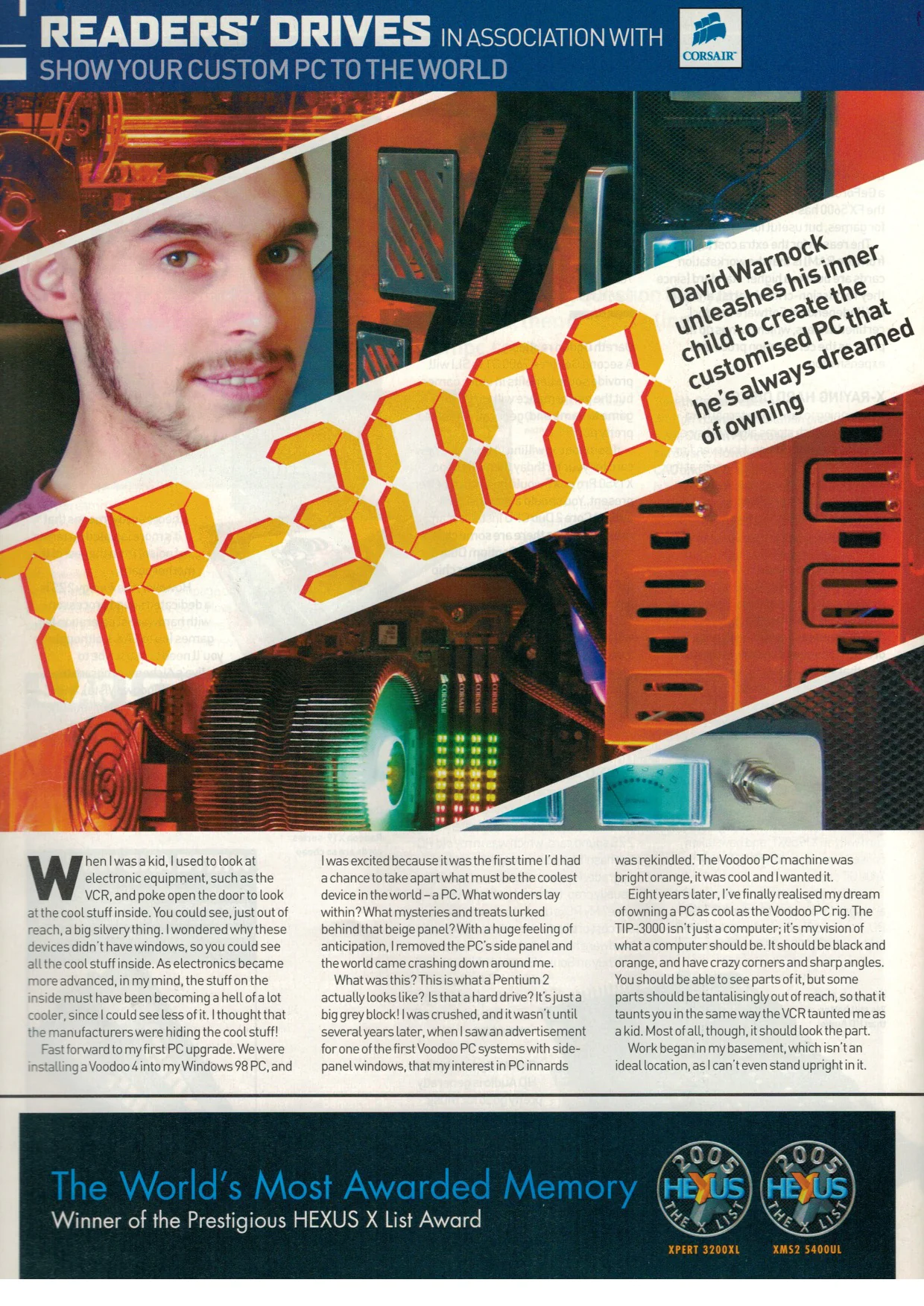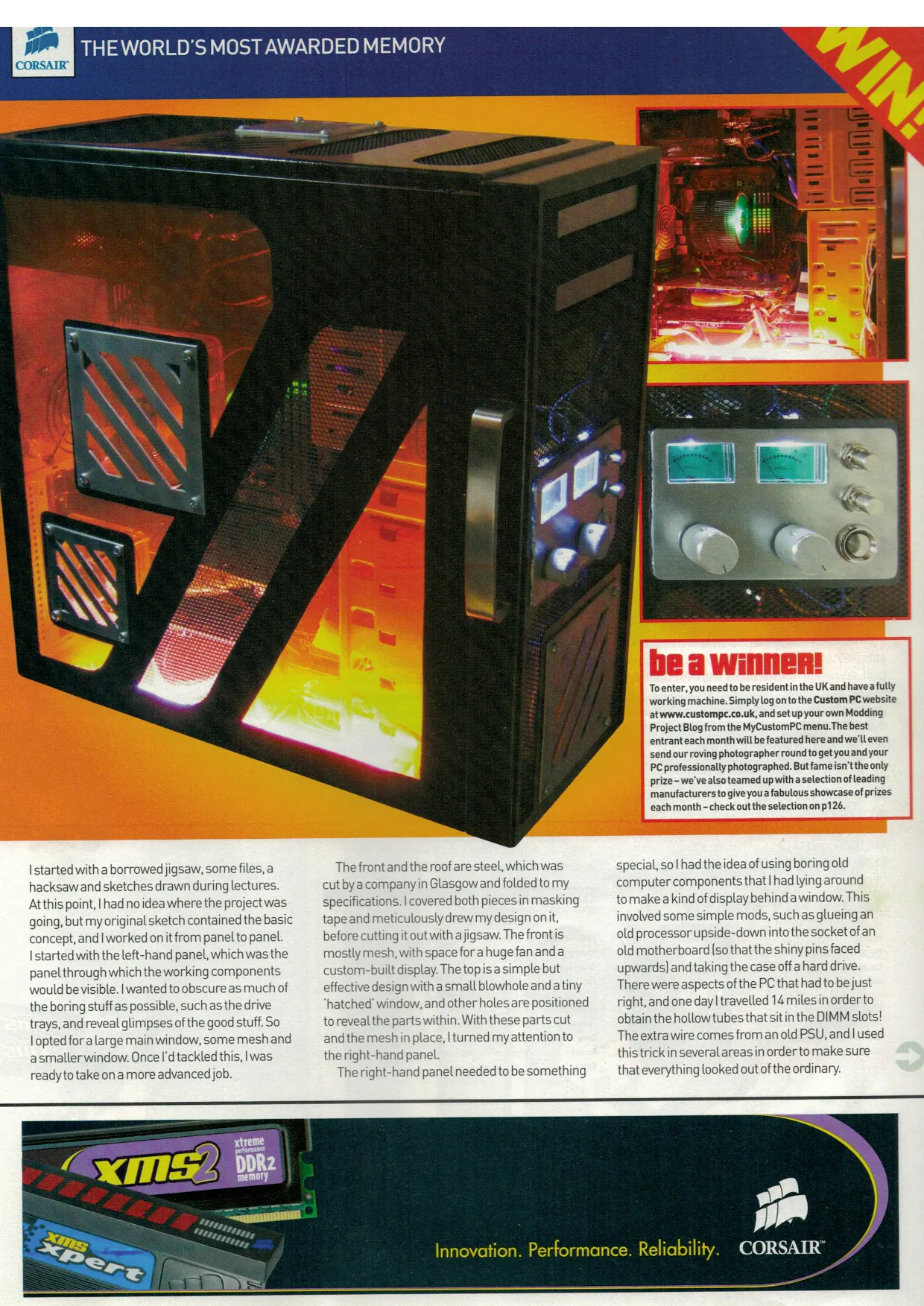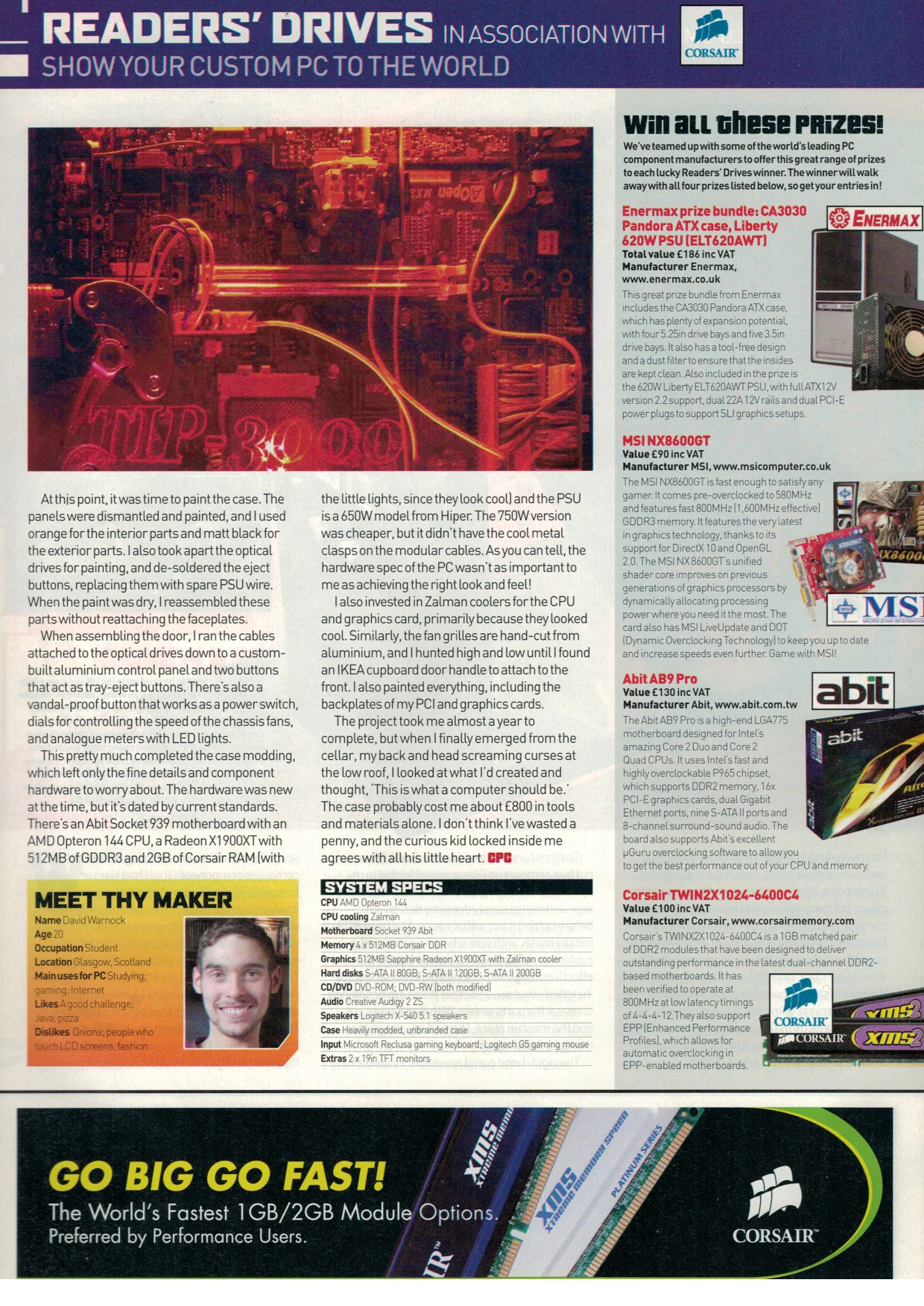TIP-3000
Custom PC Reader’s Drives
After I had finished building the TIP-3000, I submitted it to Custom PC’s “Reader’s Drives” competition. I wasn’t actually expecting much but they quickly got in touch with me and told me that I had won, asking me to provide pictures to their specifications and to write about the machine.
I did all this and was published in issue 49 of the magazine, published in October 2007. This was just after I’d got out of hospital for a very serious operation, and I was in extremely poor health (as you’ll see in the photographs). This was just what I needed to put a smile back on my face.
I won some high-end parts, which seems like an odd prize for a computer competition for people with custom computers. I had high hopes for the Asus motherboard but I couldn’t get it to stay stable, so I eventually bought another Gigabyte motherboard and flogged the Asus. I made the guy buying it aware that it might be buggered so he knew what he was getting, and only took a tiny amount of it’s theoretical value - I think about £20.
Anyway, here is the original article’s text.
Original Article
When I was a kid, I used to look at electronics, like the VCR, and poke open the door to look at the cool stuff inside. It was cool: you could see, tantalisingly out of reach, a big silvery thing. I always wondered why these things didn’t have windows, so you could see all the cool stuff. As time went on, electronics got more advanced, and in my mind, the stuff on the inside must have been getting a hellovalot cooler, because I could see less of it. The manufacturers were hiding the cool stuff!
I think my heart was broken the day I upgraded my first graphics card. It was a Voodoo 4, and we were running Windows 98. It was the first time I’d had a chance to take apart what must be the coolest device in the world… a PC. What wonders lay within? What mysteries and treats were behind that beige panel? I took off that side panel with a dream in my heart, and it all came crashing down.
What was this? That’s what a Pentium 2 actually looks like? Is that a hard drive? It’s just a big grey block! I was crushed till, a few years later, I was reading PC Gamer and I saw advertised one of the first Voodoo PCs with side windows. It was bright orange, it was cool and I wanted it. At that point a new dream was born.
Here I am, 8 years later, and that dream has finally become a reality. The TIP-3000 isn’t just a computer; it’s my vision of what a computer should be. It should be black, and orange, and have crazy corners and sharp angles. You should be able to see bits of it, but not quite everything, just like when you peeked in the VCR as a kid. But most of all, it should look the part.
Work started in my basement, a place I can’t even stand up straight. I started with a borrowed jigsaw, some files, a hacksaw and some sketches drawn during lectures. At this point I had no idea where the whole thing was going to go, but my original sketch had the basic ideas of my dream, and I worked on it from panel to panel. I started with the left panel, the one you’d see the working components through. I wanted to obscure as much of the boring stuff, such as the drive trays, and reveal tantalising glimpses of the good stuff. So I opted for a large main window, some mesh, and a smaller window. Once I’d cut this, I was ready to take on something more advanced.
The front and the roof are steel, cut by a company in Glasgow and folded to my specifications. I covered both pieces in masking tape and meticulously drew my design on it, before cutting them out with a jigsaw. The front is mostly mesh, with space for a huge fan and a custom-built display. The top is a simple but effective design with a small blowhole and a tiny ‘hatched’ window, along with some other holes cut and positioned to reveal the parts within. With these parts cut and the mesh in place, I turned my attention to the right panel.
The right hand panel needed to be something special, so I thought “why not take those boring old parts and make them look cool?” So I did, from doing simple things like gluing the processor in upside down and taking the lid of a hard drive. Some of the things I just had to get right, and one day I travelled 14 miles in order to get the hollow tube in the RAM slots: all that’s in there is copper wires! All the extra wire comes from an old PSU, and I used this trick in several places in order to make sure nothing looked too standard.
At this point it was time to paint. All the panels were dismantled and painted, orange for the interior parts and matt black for any exterior parts. I also took apart the optical drives for painting and took the opportunity to de-solder the eject buttons, replacing them with spare PSU wire. When the paint was dry, I reassembled these parts without putting on the faceplates.
When assembling the door, I ran these cables down to a custom built aluminium control panel. A large vandal-proof button provides a power switch, with small buttons for the CD drives, dials for controlling the speed of the case and the chassis fans, and some analogue meters with LED lights.
This pretty much completed all the functional parts, leaving only details and hardware to worry about. Hardware was new at the time, but dated today; an ABit 939 Motherboard with an AMD Opteron 144, A Radeon XT1900 with 512MB of DDR3, 2GB of Corsair RAM with the little lights. The hardware was good at the time, but not as important to me as getting that feeling right.
As such, I invested in aftermarket Zalman coolers, not primarily because of their cooling ability, but because they looked cool. The RAM was chosen because it lights up in a cool way. The PSU is a Hyper 650 Watt: I could have got the 750 Watt version cheaper, but it didn’t have the cool metal clasps on the modular cables-instead it had plastic clips.
No, everything had to be just right. The fan grilles were hand cut from aluminium. I hunted high and low till I found an IKEA cupboard door handle to attach to the front. I painted everything, including the backplates of my PCI and graphics cards.
It took almost a year to complete. When I finally emerged from the cellar, my back and head screaming curses at the low roof, I looked at what I’d created. This wasn’t just a computer: this is what a computer aught to be. The case probably cost me about £8001 in tools and materials alone; all of the money my own earnings. I don’t think I’ve wasted a penny, and the curious kid locked inside me agrees with all his little heart.



-
It’s true that I spent a lot of money on tools and parts but I’m still suspicious of this number. ↩
